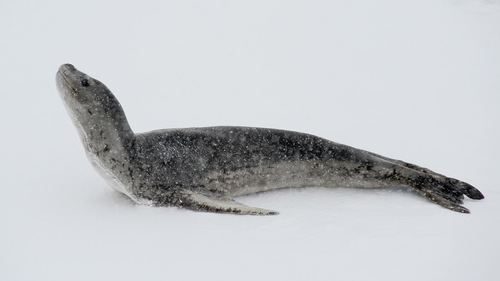
Leopard Seal
The leopard seal, with its sleek, spotted coat and menacing jaws, reigns the icy Antarctic waters. A solitary hunter, it thrives on a diverse diet, including penguins. Its curious yet solitary nature and key role as a top predator highlight its ecological importance in the polar marine ecosystem.
20-24 years
Lifespan
200.0 - 591.0 kg
Weight
Grey, Black
Color
25 mph
Top Speed
Least Concern
Conservation Status
Unknown
Population Trend
Characteristics
The leopard seal (Hydrurga leptonyx) is a formidable predator found in the icy waters of the Antarctic and sub-Antarctic regions. Notable for its long, slender body and powerful jaws, it preys on penguins, fish, and other seals. Its distinctive spotted coat and solitary, curious nature set it apart.
Distribution Range of the Leopard Seal
Hydrurga leptonyx, commonly known as the leopard seal, is native to the Antarctic region. It is predominantly found around the continent of Antarctica, including the surrounding sub-Antarctic islands. The geographical distribution extends to the southern parts of the Atlantic, Indian, and Pacific Oceans, reaching the coasts of South America, New Zealand, Australia, and South Africa occasionally.
Leopard Seal's Habitat
Environmental Conditions
Leopard seals primarily inhabit the pack ice zones of Antarctica. They are adapted to cold polar environments with temperatures often below freezing. The habitat is characterized by a mixture of ice floes, open water, and sometimes the coastal regions of the Antarctic continent.
Ecological Niche
Leopard seals are apex predators within their ecological niche, feeding on a variety of prey including penguins, fish, krill, and other seals. They are solitary animals that rely on their excellent swimming ability and powerful jaws to hunt. The pack ice provides both a hunting ground and a place to rest and breed. Their distribution and hunting patterns are closely tied to the availability of prey and the seasonal movement of the ice.
Copyright @ Nature Style Limited. All Rights Reserved.
 English
English